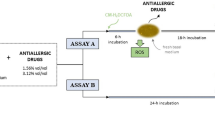Abstract
Introduction
The purpose of this study was to determine the effects of two commercially available combination topical ophthalmic medications on human ocular surface cells in vitro.
Methods
Tissue culture plates (96-well) containing immortalized human corneal and conjunctival epithelial cells were divided into five groups. The test solutions examined were: timolol 0.5%+brimonidine 0.2%, containing 0.0050% benzalkonium chloride (BAK); timolol 0.5%+dorzolamide 2%, containing 0.0075% BAK; and preservative-free artificial tears. Balanced salt solution (BSS) was used as the live control, and a fixative solution containing 70% methanol and 0.2% saponin was used as the dead control. Cells were exposed to 100 μL of test or control solution for 25 minutes at 37°C and 5% carbon dioxide (CO2). A live cell assay was used to measure the toxicity of combination treatments compared with BSS controls.
Results
Exposure to timolol 0.5%+brimonidine 0.2% resulted in a significantly higher percentage of living conjunctival cells (48%±12%) as compared with timolol 0.5%+dorzolamide 2% (10%±5%, P<0.00001). In corneal cells, testing revealed 12%±3% live cells after timolol 0.5%+brimonidine 0.2% exposure compared with 2%±3% after timolol 0.5%+dorzolamide 2% (P<0.001).
Conclusions
Both combination medications demonstrated a significant reduction in the percentage of live corneal and conjunctival epithelial cells compared with control. However, cell cultures exposed to timolol 0.5%+dorzolamide 2% had significantly fewer live cells compared with cell cultures exposed to timolol 0.5%+brimonidine 0.2%. Further studies are needed to better understand the clinical significance of these findings in patients using these medications for chronic treatment of glaucoma and ocular hypertension.
Similar content being viewed by others
References
Horsley MB, Kahook MY. Effects of prostaglandin analog therapy on the ocular surface of glaucoma patients. Clin Ophthalmol. 2009;3:291–295.
Noecker RJ, Herrygers LA, Anwaruddin R. Corneal and conjunctival changes caused by commonly used glaucoma medications. Cornea. 2004;23:490–496.
Pisella PJ, Debbasch C, Hamard P, et al. Conjunctival proinflammatory and proapoptotic effects of latanoprost and preserved and unpreserved timolol: an ex vivo and in vitro study. Invest Ophthalmol Vis Sci. 2004;45:1360–1368.
Kahook MY, Noecker RJ. Comparison of corneal and conjunctival changes after dosing of travoprost preserved with sofZia, latanoprost with 0.02% benzalkonium chloride, and preservative-free artificial tears. Cornea. 2008;27:339–343.
De Saint Jean M, Debbasch C, Brignole F, Rat P, Warnet JM, Baudouin C. Toxicity of preserved and unpreserved antiglaucoma topical drugs in an in vitro model of conjunctival cells. Curr Eye Res. 2000;20:85–94.
Wu KY, Wang HZ, Hong SJ. Cellular cytotoxicity of antiglaucoma drugs in cultured corneal endothelial cells. Kaohsiung J Med Sci. 2007;23:105–111.
Noecker R. Effects of common ophthalmic preservatives on ocular health. Adv Ther. 2001;18:205–215.
Epstein SP, Ahdoot M, Marcus E, Asbell PA. Comparative toxicity of preservatives on immortalized corneal and conjunctival epithelial cells. J Ocul Pharmacol Ther. 2009;25:113–119.
Whitson JT, Cavanagh HD, Lakshman N, Petroll WM. Assessment of corneal epithelial integrity after acute exposure to ocular hypotensive agents preserved with and without benzalkonium chloride. Adv Ther. 2006;23:663–671.
Yee RW, Norcom EG, Zhao XC. Comparison of the relative toxicity of travoprost 0.004% without benzalkonium chloride and latanoprost 0.005% in an immortalized human cornea epithelial cell culture system. Adv Ther. 2006;23:511–519.
Blondin C, Hamard P, Cholley B, Haeffner-Cavaillon N, Baudouin C. In vitro effects of preserved or preservative-free antiglaucoma medications on human complement system. Curr Eye Res. 2003;27:253–259.
Guenoun JM, Baudouin C, Rat P, Pauly A, Warnet JM, Brignole-Baudouin F. In vitro study of inflammatory potential and toxicity profile of latanoprost, travoprost, and bimatoprost in conjunctiva-derived epithelial cells. Invest Ophthalmol Vis Sci. 2005;46:2444–2450.
Author information
Authors and Affiliations
Corresponding author
Rights and permissions
About this article
Cite this article
Ammar, D.A., Kahook, M.Y. The effects of combination glaucoma medications on ocular surface epithelial cells. Adv Therapy 26, 970–975 (2009). https://doi.org/10.1007/s12325-009-0076-8
Received:
Published:
Issue Date:
DOI: https://doi.org/10.1007/s12325-009-0076-8




